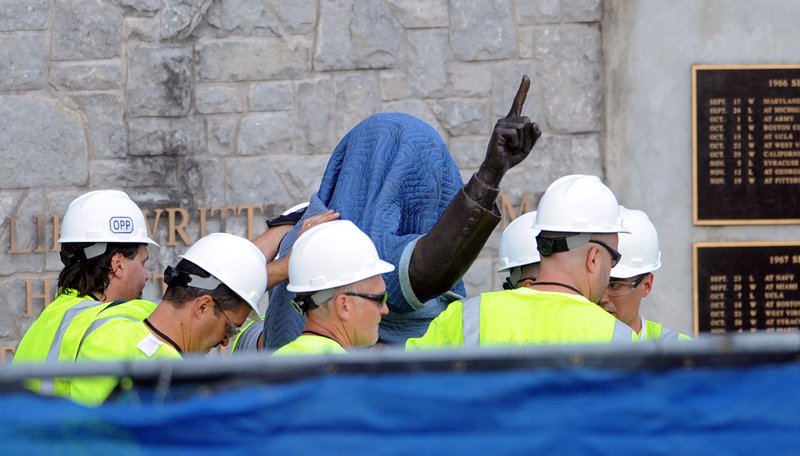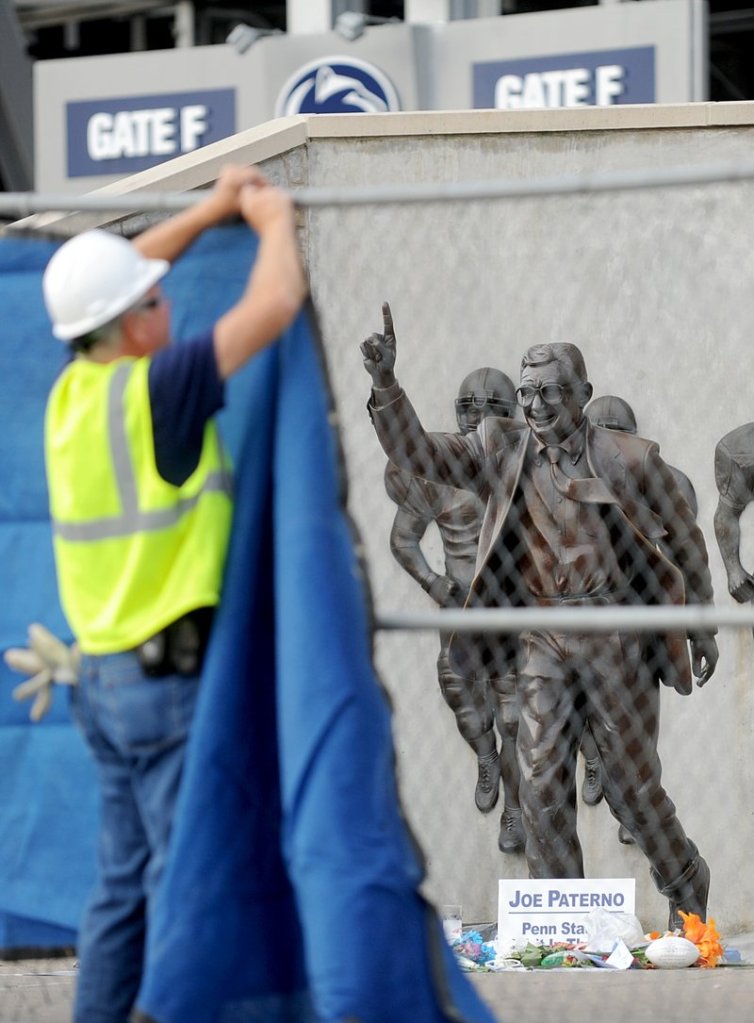STATE COLLEGE, Pa. – Cloresa Turner drove to central Pennsylvania from Virginia to see the statue of veteran Penn State football coach Joe Paterno.
When she arrived in State College on Sunday and saw that it was gone from its place outside the university stadium, she clasped her hand over her mouth.
“He’s done so much for this university. It’s sad,” said Turner, of Martinsville, Va. “To wipe it all away is like he meant nothing.”
Construction vehicles and police arrived shortly after dawn Sunday, barricading the street and sidewalks near the statue, erecting a chain-link fence and then concealing the 7-foot-tall statue with a blue tarp. Workers used jackhammers to free the statue and a forklift to lower it onto a flat-bed truck that rolled into a stadium garage bay as some of the 100 to 150 students and other onlookers chanted, “We are Penn State.”
The university announced Sunday that it was taking down the monument in the wake of an investigative report that found that the late coach and three top Penn State administrators concealed sex abuse claims against Jerry Sandusky, who was convicted last month of sexually abusing 10 boys, sometimes on Penn State’s campus.
The NCAA, meanwhile, announced Sunday that it will levy “corrective and punitive measures” today, although it disclosed no further details.
But ESPN, quoting a source, reported the penalties will probably include the loss of many scholarships and many bowl games, but will not include the “death penalty,” which would suspend the football program for at least a year.
The penalties, however, are considered to be so harsh that the death penalty may have been preferable, the source told ESPN.
NCAA President Mark Emmert hasn’t ruled out the possibility of shutting down the Penn State football program in the wake of the scandal, saying he had “never seen anything as egregious.”
At the college, Penn State President Rod Erickson said he decided to have the statue removed and put into storage because it “has become a source of division and an obstacle to healing” and would be “a recurring wound” to victims of child abuse had it remained.
The statue had become such a lightning rod for public opinion amid the child sex-abuse scandal at Penn State that even President Obama weighed in. White House Press Secretary Jay Carney told Washington reporters Sunday that Obama believed “it was the right decision” for the university to remove the monument.
Earlier, the Paterno family issued a statement saying the statue’s removal “does not serve the victims of Jerry Sandusky’s horrible crimes or help heal the Penn State community.” The family, which has vowed its own investigation, called the report by former FBI director Louis Freeh the “incomplete and unofficial” equivalent of a charging document by a prosecutor and said the only way to help the victims “is to uncover the full truth.”
“It is not the University’s responsibility to defend or protect Joe Paterno,” the statement said. “But they at least should have acknowledged that important legal cases are still pending and that the record on Joe Paterno, the board and other key players is far from complete.”
Paterno’s widow, Sue, and two of the Paternos’ children visited the statue Friday as students and fans lined up to get their pictures taken with the landmark. The statue, weighing more than 900 pounds, was built in 2001 in honor of Paterno’s record-setting 324th Division I coaching victory and his “contributions to the university.”
Some who came out to watch the statue’s removal were angry that it had been done with so little notice that many missed it — “It was under cloak of darkness,” said Diane Byerly, 63, of Harrisburg — and worried that stiff sanctions from the NCAA would punish the innocent while possibly destroying businesses that rely on the commerce from the tens of thousands who flood State College on game days.
“I think there’s ways you can punish the parties involved without affecting all of State College,” said Richard Hill, a 1967 graduate from West Chester.
Chris Stathes, 40, a lifelong Penn State football fan who has a daughter at the school and manages two State College breakfast eateries, said shutting down the program would devastate local businesses.
“Football season, that’s our moment. From the time we open our doors in the morning until kickoff, there’s a line out the door,” he said.
Philip Frum, 24, who works on research projects for Penn State, said he hoped the statue would be erected elsewhere, such as at a nearby Penn State sports museum.
“This statue was a symbol of all the good things he’s done for the university,” Frum said. Any NCAA penalty that shuts down the football program “will be just as bad as taking down the statue,” he said.
By late afternoon, people continued to stream in to see the site, several leaving flowers or notes at the temporary chain-link fencing that kept people a short distance away. One note said: “They may erase you from this site, but never from our hearts.” Another read: “WE ARE always going to remember,” a play on the school’s call-and-response cheer, “We are … Penn State.”
The university president said Paterno’s name will remain on the campus library because it “symbolizes the substantial and lasting contributions to the academic life and educational excellence that the Paterno family has made to Penn State University.”
The statue’s sculptor, Angelo Di Maria, said he felt like a part of him was being taken down with it.
“When things quiet down, if they do quiet down, I hope they don’t remove it permanently or destroy it,” Di Maria said. “His legacy should not be completely obliterated and thrown out. … He was a good man. It wasn’t that he was an evil person. He made a mistake.”
Send questions/comments to the editors.




Success. Please wait for the page to reload. If the page does not reload within 5 seconds, please refresh the page.
Enter your email and password to access comments.
Hi, to comment on stories you must . This profile is in addition to your subscription and website login.
Already have a commenting profile? .
Invalid username/password.
Please check your email to confirm and complete your registration.
Only subscribers are eligible to post comments. Please subscribe or login first for digital access. Here’s why.
Use the form below to reset your password. When you've submitted your account email, we will send an email with a reset code.